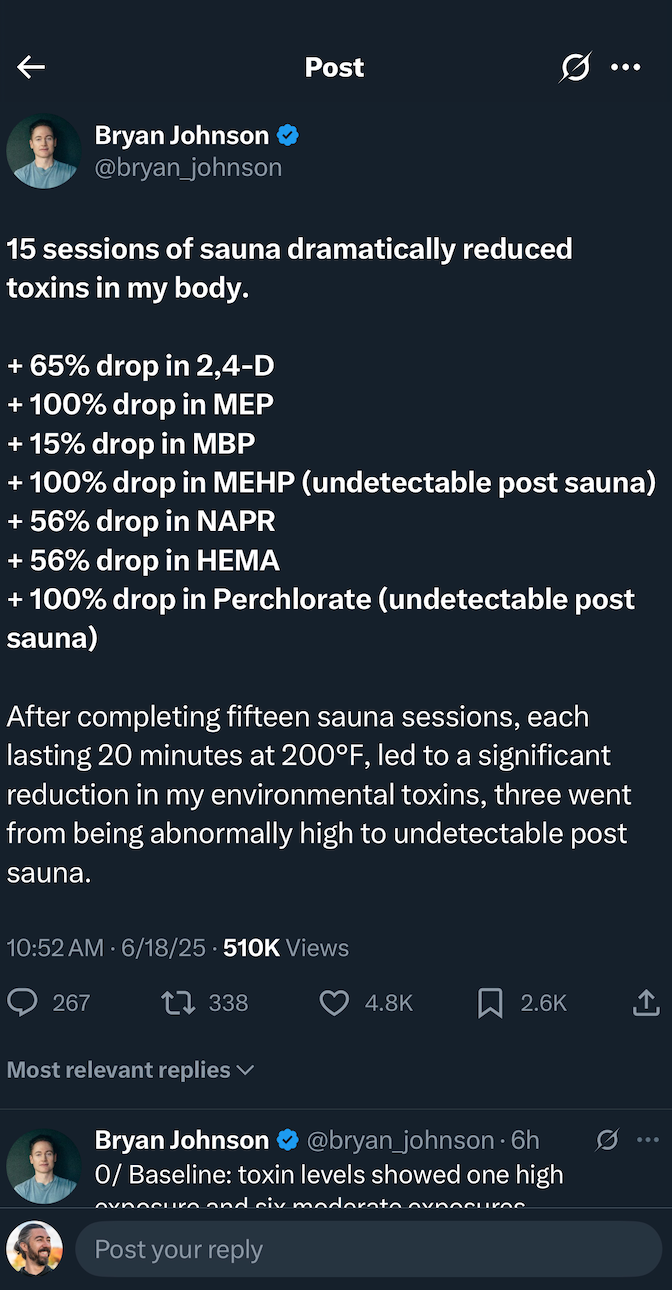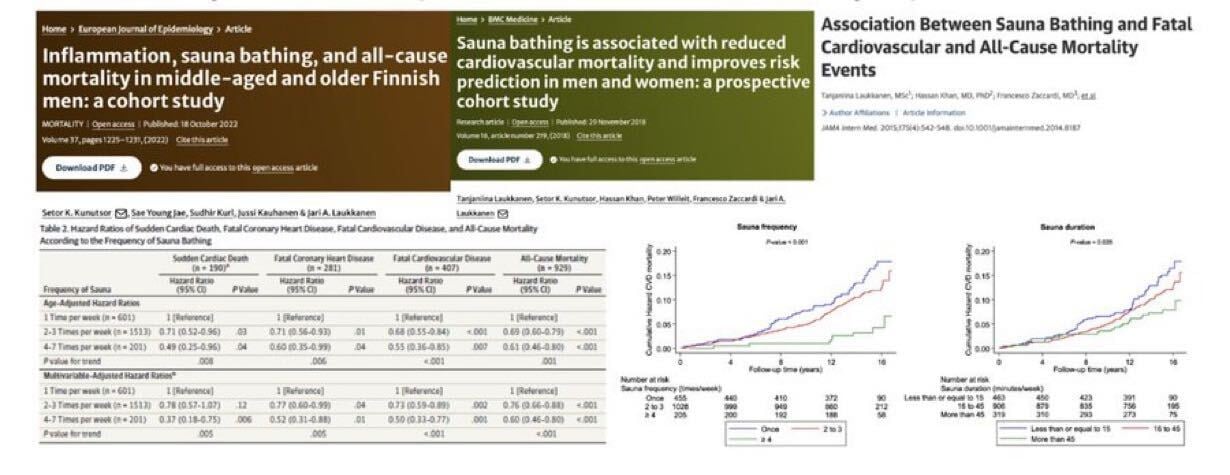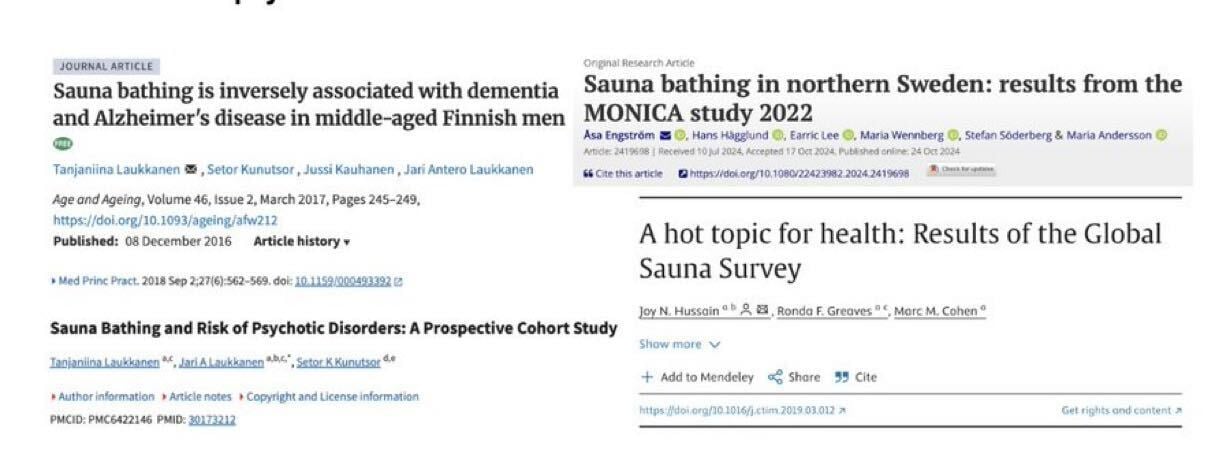There's evidence that sauna is a potential detox and longevity intervention with benefits to heart, metabolism, brain health, and skin. We’re going to put it to the test.
Here’s what you need to know…

0/ Baseline: toxin levels showed one high exposure and six moderate exposures. Approximately one month prior to starting the sauna regimen, urine tests indicated one high exposure (levels exceeding the 95th percentile), and six moderate exposures ( levels between the 75th and 95th percentiles).Post-sauna: high exposures completely eliminated, only one medium exposure remained, and three previous moderate exposures became undetectable.
Here are toxins that sauna helped me eliminate from my body, and why it matters:
1/ 2,4-Dichlorophenoxyacetic Acid (2,4-D)
High exposure → lower medium exposure
2,4-D is a herbicide, so it is probably leaking into my food via some fresh produce, which is very hard to monitor due to batch variation. I have been testing periodically and will continue to do so.
2/ Phthalates
MEB and MEHB: medium exposure → undetectable
MHB: medium → detectable within “normal” range
MEB MHB and MEHB are three phthalate metabolites, phthalates are among the most common plastic-leachables and endocrine disruptors and also associated with various neurological, respiratory, reproductive issues in addition to some cancers. Eliminating phthalates from my body will spare me all these risks and disruptions.
3/ Volatile Organic Compounds VOCs
NAPR (1-Bromopropane metabolite): medium exposure → detectable within normal range
HEMA ( Ethylene Oxide, Vinyl Chloride metabolite): medium exposure → detectable within normal range
NAPR, a metabolite of 1-bromopropane, an industrial solvents and volatile organic compounds (VOCs), was previously detected at moderate levels.
HEMA is a metabolite of ethylene oxide and vinyl chloride, both widely used in the plastic industry, HEMA detection signifies exposure to either or both of these toxins, it was previously detected to moderate levels in my urine.
These VOCs, common industrial pollutants linked to wild and urban fires, likely stemmed from my exposure to the LA fires in January, where I registered high VOC levels on January 28th. Though levels had partially normalized by late March (the baseline), consistent sauna sessions have now partially eliminated these VOCs, with both NAPR and HEMA being in the “normal” exposure levels. Significantly reducing the risks of liver damage, multisystem disruptions and carcinogenic risks associated with benzene and 1-bromopropane, and the carcinogenic risks associated with long term exposure to ethylene oxide (lymph nodes cancer risk) and vinyl chloride (liver cancer risk).
4/ Perchlorate
Perchlorate: medium exposure → undetectable
A pervasive environmental toxin, perchlorate is found in fireworks, road flares and rocket fuel and can enter the food chain through contaminated irrigation water and even milk.
It's a known thyroid disruptor, with pregnant women, infants, and children being particularly vulnerable to its effects.
For me, with a history of hypothyroidism and lifelong thyroid medication, the complete elimination of this toxin through sauna sessions is incredibly positive news.
5/ Evidence so far, the significance of this new data
While sauna is commonly referred to as a detox intervention, research on the subject has been limited, especially as it pertains to eliminating toxins from everyday life exposures.
Research so far focused on sauna's potential to help detoxing heavy metals, and some abuse drugs in the contexts of long term occupational exposures.
Moreover, most research on detox did not use the Finnish sauna protocol, most well studied for chronic disease prevention, especially cardiovascular disease.
To our awareness this data is unique in showing saunas potential of detoxifying a broad range of organic toxins from every day environmental exposure using the most standardized and well studied sauna protocol.
While sauna use is often touted for detoxification, research has been limited, particularly regarding the elimination of everyday environmental toxins.
Existing studies have primarily focused on sauna's potential to detoxify heavy metals and certain drugs in cases of prolonged occupational exposure.
Furthermore, many detoxification studies have not employed the Finnish sauna protocol, the most extensively researched method for chronic disease prevention, especially cardiovascular health.
This data (despite being a short study in an N=1) demonstrates sauna's effectiveness in detoxifying a wide array of organic toxins resulting from daily environmental exposures, using the most standardized and well-studied sauna protocol.
POSTED: 5/14/25
Interesting effects from 7 days of sauna (200°F for 20 min). It's early and I'll get more data in the coming weeks so we'll see.
Central systolic blood pressure 103→97 mmHg:
My heart, brain and all major organs are experiencing 5.83% less pressure than a week ago. I started in the lower normal range, now it is even lower in the lowest 2.5-5% for 20-year olds.
Central pulse pressure 28→22 mmHg:
21.43% more flexible aorta and less load on my heart.
Augmentation pressure 2→1 mmHg, and augmentation index 8→6 %
Both indicating further decrease in my arterial stiffness and increase in aortic compliance.
Subendocardial variability ratio SEVR 220-212%
Small downwards shift of 3%, while still in mid normal range reflecting normal heart oxygenation.
How sauna helps achieve these results?
Heat-induced vasodilation and lower sympathetic activity at rest due to repeated heat exposure.
Arterial structure remodeling and increased aortic elasticity.
Confounders to rule out
Change could be due to a small reduction in plasma volume due to repeated heat exposure, will rule out by testing my urine for hydration markers and keeping them stable.
Change can also be within the normal levels of variance for this measurement, this can be ruled out with repeated measurements showing the same trend as I continue my sauna protocol.
These improvements are in line with the strong clinical evidence supporting the cardiovascular protective effects of sauna.

POSTED: 5/14/25
My body sweats 18 oz during a 20 min sauna at 200 °F, with a sodium concentration of 25-39 mg/oz.
A single sauna session flushes 450–700 mg of sodium out of my body. ~30-50% of ideal daily intake.
I measured this because I got intense muscle cramps during sleep after starting sauna and needed to figure out the electrolyte balancing.
These results now inform my sodium sweat profile (everyone is different) and needed fluid intake before and after.
My protocol is to consume 20 oz before and 20 oz after each sauna session, each with 350 mg of sodium, 80 mg of potassium and 24 mg of magnesium. This is a Blueprint concoction that we've sourced and tested ourselves.
I used the Gatorade Sweat Patch for measurement.

POSTED: 5/7/25
0/ How it works
Heat exposure in a sauna puts your body under mild stress, triggering natural repair processes that improve overall health. Finnish dry saunas specifically use controlled heat to stimulate these beneficial responses, including: Repairing and maintaining proteins (heat shock proteins)
+ Improving blood flow and relaxing blood vessels
+ Boosting antioxidant activity
+ Optimizing metabolism
+ Enhancing fitness
+ Reducing inflammation
+ Strengthening immunity
+ Recycling and repairing cells (autophagy)
All these processes combine to give whole-body health benefits.

1/ It protects your heart
Regular sauna use (4–7 times a week, sessions lasting at least 19 minutes) can significantly improve heart health and lower blood pressure. Research shows the more often you sauna, the greater your protection from heart disease:
Heart disease risk:
2–3 times/week → 23% lower risk
4–7 times/week → 48% lower risk
High blood pressure risk (in healthy men aged 42–60):
2–3 times/week → 17% lower risk
4–7 times/week → 47% lower risk
In patients with existing heart failure, using a sauna 5 times a week for 3 weeks improved heart function by nearly 7%, lowered stress hormones by 25%, and reduced heart failure markers by over 20%. Longer and more frequent sauna sessions offer the strongest protection.

2/ It can improve mental health
Regular sauna use can lower your risk of dementia and boost your overall mental health.
+ Better sleep: Over 80% reported improved sleep quality.
+ Reduced pain: 33% experienced less muscle pain.
+ Happier mood: Regular sauna users (1–4 times/week) report feeling happier and less stressed.
+ Lowers dementia risk: lowers by 21% (2–3 times/week) and 48% (4–7 times/week)
+ Lowers psychotic disorder risk: 4–7 times/week → 77% lower risk

3/ Reduces inflammation
Regular sauna use reduces inflammation and can ease autoimmune conditions. Studies in healthy middle-aged men show frequent sauna use lowers systemic inflammation significantly:
2–3 sessions/week: 17% lower inflammation
4–7 sessions/week: 31.5% lower inflammation
These anti-inflammatory benefits grow stronger with increased sauna frequency and are sustained over the long term. Sauna use notably reduces markers like hsCRP, fibrinogen, and white blood cell count, all linked to chronic inflammation.
As a result, regular sauna sessions improve quality of life and ease symptoms in chronic inflammatory and autoimmune diseases, such as rheumatoid arthritis.

4/ It can improve your metabolism
Sauna can improve your body composition, metabolism, and fitness levels.
It has shown:
+ Significant decrease in bad cholesterol (total cholesterol and LDL)
+ Transient significant decrease in blood fat (triglycerides)
+ Small increases in good cholesterol (HDL)
These benefits were seen in young men completing 10 sauna sessions (3 x 15 minutes, 2 min cool-downs in between).
In a low powered study (small sample size with additional limitations), research also showed a 1.07% increase in muscle mass & 7.7% increase in bone mineral density. This is based upon 12 days of high-temperature (100°C) long sauna sessions (5 x 10 min each) across 4 weeks.

5/ It may detox you
Sauna may be effective for detoxifying your body. Your skin naturally helps flush out toxins through sweating, including heavy metals and certain harmful compounds. Research shows that sauna-induced sweating significantly boosts the removal of common environmental toxins like arsenic, cadmium, lead, and mercury.
Longer sauna sessions (15–20+ minutes) can help clear out stubborn, fat-soluble toxins stored in the body.
Additionally, sauna therapy has successfully reduced toxic buildup from chronic exposure to substances like methamphetamines, demonstrating its potential for powerful detoxification.
6/ What about longevity?
Regular sauna use is linked to a longer lifespan. Multiple studies show that frequent, long-term sauna sessions significantly lower your risk of dying from all causes. Regular sauna use (3–7 times/week) specifically reduces the increased mortality risk from chronic inflammation (high CRP).
All-cause mortality risk (sessions >19 min):
2–3 times/week → 24% lower
4–7 times/week → 40% lower
Effect of session length:
11–19 mins → 9% lower
Over 19 mins → 17% lower
Additionally, long-term sauna use dramatically lowers the risk of dying from heart disease in men and women (average age 63, followed for 15 years):
2–3 times/week → 29% lower
4–7 times/week → 70% lower
7/ My protocol
My sauna protocol:
+ Type: Dry sauna (@thecoldplunge)
+ Temperature: 200 °F (93° C)
+ Frequency: daily, 7 days a week
+ Duration: 20-minute sessions
+ Protection: Ice pack applied to the groin area to safeguard testicular and sperm health.
+ Rehydration: 36 oz mineral-supplemented water to replenish minerals (via Blueprint electrolytes ETA this summer)
8/ How I will measure effect
Potential Benefits
+ Enhanced cellular repair mechanisms, focusing on protein and cellular maintenance and repair.
+ Increased metabolic efficiency.
+ Improved physical fitness and exercise endurance.
+ Better cardiovascular health.
+ Enhanced neurological function.
+ Possible positive changes in the gut microbiome.
Measurements
+ Heart Rate Variability (HRV)
+ Resting Heart Rate (RHR)
+ Blood Pressure (BP)
+ VO2max, grip strength, and muscle oxygenation (MOXY)
+ Bone Mineral Density (BMD)
+ Muscle Mass
+ Visceral and liver fat
+ Endothelial function markers (ADMA/SDMA, NO, and F2-Isoproteins)
+ Inflammation markers (CRP, IL-6, IL-10, TNF-a, and MMP-9)
+ Neurological markers P-tau 217 and S-100B
Bonus
+ Salt content in sweat to track my need for mineral fortification for dehydration
9/ Tips for you
+ Aim for 3–5 sauna sessions per week, lasting about 15–20 minutes each, at 175–194°F (80–90°C)
+ After workouts is ideal, as sauna use boosts muscle recovery. Always hydrate thoroughly afterward
+ Be cautious above 194°F (90°C). Cover your head with a damp cloth, breathing through it to protect your airways
+ Never use a sauna when dehydrated, and drink plenty of water afterwards to rehydrate
+ Use minerals+water to dehydrate in case you are a salty sweater (can be measured)
Skip sauna sessions if you:
+ Have serious heart issues or uncontrolled blood pressure
+ Are pregnant (consult your doctor)
+ Have an infection, fever, or feel unwell
+ Have a history of seizures
+ Struggle with respiratory conditions (asthma, COPD)
+ Have irritated or inflamed skin
+ Recently consumed alcohol or recreational drugs
+ Are taking medications such as beta-blockers, stimulants, anticholinergics, or diuretics

















